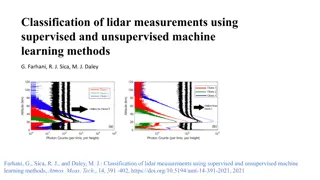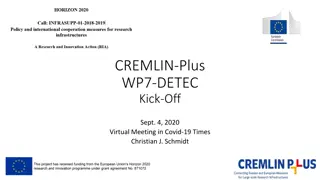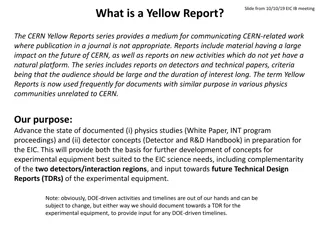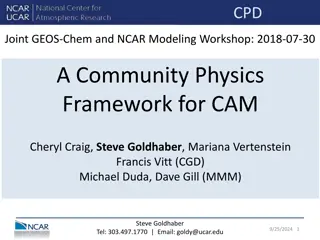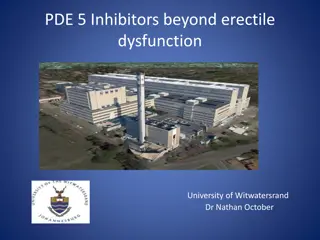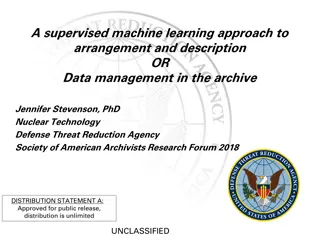Advancing Physics-Informed Machine Learning for PDE Solving
Explore the need for numerical methods in solving partial differential equations (PDEs), traditional techniques, neural networks' functioning, and the comparison between standard neural networks and physics-informed neural networks (PINN). Learn about the advantages, disadvantages of PINN, and ongoing research focused on enhancing the efficiency of network solutions for specific problems like blood flow through blockages.
Download Presentation

Please find below an Image/Link to download the presentation.
The content on the website is provided AS IS for your information and personal use only. It may not be sold, licensed, or shared on other websites without obtaining consent from the author. Download presentation by click this link. If you encounter any issues during the download, it is possible that the publisher has removed the file from their server.
E N D
Presentation Transcript
TOWARDS IMPROVED PHYSICS- INFORMED MACHINE LEARNING Ethan Shoemaker, Undergraduate Researcher Dr. Amirhossein Arzani, Faculty Advisor
INTRODUCTION Why do we need numerical methods of solving partial differential equations (PDEs)? Traditional methods of solving PDEs How do neural networks work? Standard neural networks vs. physics-informed neural networks (PINN) Advantages and disadvantages of PINN Results of research
WHY WE NEED NUMERICAL METHODS OF SOLVING PDEs Most PDEs cannot be solved analytically e.g. Navier-Stokes Equations, Heat Equation Figure 2: Heat Equation Figure 1: Navier-Stokes Equations
TRADITIONAL METHODS OF SOLVING PDEs Discretized methods Finite Element Method Finite Volume Method Finite Difference Method Fourier Transform Other mesh-free methods
HOW DO NEURAL NETWORKS WORK? Each link between neurons has an associated function y = Ax + b Non-linearity imposed on y with activation functions (e.g. swish, ReLu) Output is checked against a dataset to train the network The hope is that after training, the network will be able to approximate the output as a function of the input Figure 3: Neural Network Diagram
STANDARD NEURAL NETWORKS VS PINN Standard Neural Network Computes loss associated with training data only (purely data- driven) PINN Computes loss associated with training data and the associated PDE (hybrid; data-driven and physics-driven) Figure 4: PINN Diagram
PROS AND CONS OF PINN Pros Can sometimes solve PDEs without the use of boundary conditions! (uses sparse data instead) Easy to learn how to use Cons Very slow compared to traditional methods (CFD) Often requires expensive computing equipment (GPUs)
MY RESEARCH Improve the speed of a given network in solving a well-posed (known boundary conditions) problem, blood flow through a stenosis (blocked artery) Modify the network in a manner that it can solve for fluid flow velocity field in a stenosis without the use of inlet and outlet boundary conditions (instead by using sparse pressure data)
SOLVING FOR VELOCITY FIELD WITHOUT BOUNDARY CONDITIONS Use sparse pressure data from ground-truth CFD simulation instead of boundary conditions (virtual experiment) Further this network to be able to do the same thing with only 2 pressure data points similar to FFR (pressure measurement for heart disease patients) measurements taken in clinical settings
INITIAL RESULTS Figure 6: CFD Pressure (Initial Pressure Sensor Locations) Figure 7: CFD Velocity Magnitude (Ground Truth) Figure 9: PINN Velocity Results Figure 8: PINN Pressure Results
SMARTER SENSOR LOCATIONS Figure 10: CFD Pressure (Smarter Pressure Sensor Locations) Figure 11: CFD Velocity Magnitude (Ground Truth) Figure 12: PINN Pressure Results Figure 13: PINN Velocity Results
FFR SENSOR LOCATIONS Figure 14: CFD Pressure (FFR Pressure Sensor Locations) Figure 15: CFD Velocity Magnitude (Ground Truth) Figure 16: PINN Pressure Results Figure 17: PINN Velocity Results
FUTURE WORK Develop the ability to produce the same level of accuracy in 3 dimensions Further decrease time required to converge to an accurate solution
THANK YOU Lab Principal Investigator: Dr. Amir Arzani Other Acknowledgments: Maryam Aliakbari https://www.cardiolab.nau.edu










